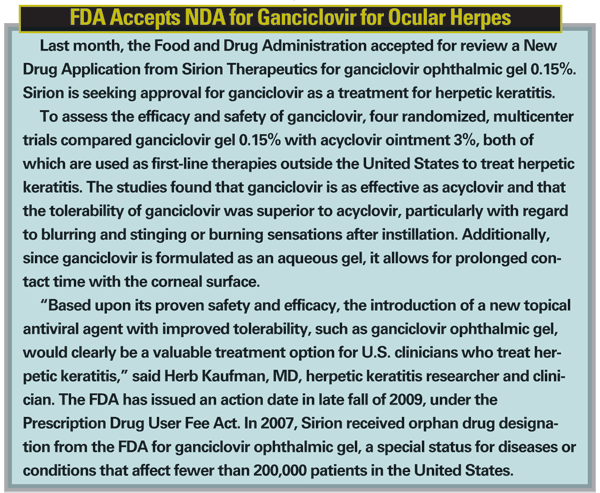The Food and Drug Administration recently approved two new intraocular lenses for cataract surgery: Advanced Medical Optics' Tecnis Multifocal intraocular lens and Alcon's AcrySof IQ ReSTOR +3 D.
AMO says the Tecnis Multifocal IOL's unique design gives patients superior near vision and reading speed compared to other presbyopia-correcting IOLs, as well as high spectacle independence, with nearly 9 out of 10 patients reporting that they never wear glasses after surgery.
Other features/benefits include:
• high-quality vision for near, far and intermediate distances, day or night;
• first and only pupil-independent, non-apodized fully diffractive aspheric lens designed to correct the two highest order aberrations—spherical and chromatic—to give patients back their youthful vision;
• 95 percent patient satisfaction—the highest of any presbyopia-correcting IOL.
"The Tecnis Multifocal IOL delivers a predictable and consistent full range of vision," said Ralph Chu, MD, director of the Chu Vision Institute in
"The full diffractive surface of the Tecnis Multifocal IOL provides high-quality vision largely independent of pupil size and reduces chromatic aberration for better image quality," said
Tecnis Multifocal IOLs are indicated for primary implantation for the visual correction of aphakia in adult patients with and without presbyopia in whom a cataractous lens has been removed by phacoemulsification and who desire near, intermediate, and distance vision with increased spectacle independence. The IOLs are intended to be placed in the capsular bag. AMO plans to ship Tecnis Multifocal IOLs to
Alcon AcrySof IQ ReSTOR +3 D was introduced in many major markets outside the
The

ISTA Reports Positive Results on Dry-Eye Treatment
Ista Pharmaceuticals announced positive results from its Phase IIb clinical study of ecabet sodium, which is being developed as a treatment for dry-eye disease. Patients treated with ecabet sodium achieved a strong positive trend in the objective sign of tear-film breakup time and a positive trend in the objective sign of quantity of tears produced (Schirmer Test). In contrast, there were no trends seen in the placebo group for either objective sign. In addition, there were no trends seen in either group in subjective symptoms as measured by the Ocular Surface Disease Index or patient's worst reported symptom. In Phase II tests where observations are not powered to show statistical significance, strong and positive trends are used as indicators of potential efficacy in subsequent Phase III studies.
Ista is also expecting results from a Phase II clinical trial studying the potential of a lower strength of Xibrom to treat dry-eye disease in the first half of 2009. Once this lower-strength Xibrom trial is completed, the company will decide which product or products to move into Phase III trials, which could start as early as 2010.
Ista's previous two Phase II trials of ecabet, which were conducted in a controlled environment chamber, demonstrated positive trends in patients' symptoms (OSDI and patient's worst symptom, both trials) and in the signs of corneal staining (one trial) and blink rate (both trials). Ista believes that given the ability to demonstrate a positive effect on signs in the environment and on symptoms in the controlled environment chamber, there is now a clear path forward to Phase III studies and New Drug Application filing for this product.
Glaucoma Drug Side Effect Becomes Lash Enhancer
Also receiving FDA approval last month was Allergan's Latisse (bimatoprost ophthalmic solution) 0.03%, as a novel treatment for hypotrichosis of the eyelashes. Latisse is the first and only science-based treatment approved by the FDA to enhance eyelash prominence as measured by increases in length, thickness and darkness of eyelashes.
Latisse is a once-daily prescription treatment applied to the base of the upper eyelashes with a sterile, single-use-per-eye disposable applicator. Latisse users can expect to experience longer, fuller and darker eyelashes in as little as eight weeks, with full results in 16 weeks. To maintain effect, continued treatment with Latisse is required. If use of Latisse is discontinued, eyelashes will gradually return to where they were prior to treatment over a period of weeks to months (average eyelash hair cycle). Latisse was clinically tested in a pivotal Phase III, multicenter, double-masked, placebo-controlled study to assess its safety and efficacy in which all endpoints (improved eyelash prominence, length, thickness and darkness) were met. Like Botox (botulinum toxin type A), which was first approved by the FDA as a medical treatment for eye disorders and was later found to have an aesthetic benefit, bimatoprost, the active ingredient in Latisse, was first approved in 2001 as a medical product to lower intraocular pressure in people with open-angle glaucoma or ocular hypertension. Patients treated with bimatoprost experienced eyelash growth as a side effect.
In the pivotal Phase III study, 278 healthy adult patients with no active ocular disease and with baseline minimal or moderate eyelash prominence were randomized to apply either Latisse or vehicle to both upper eyelid margins once daily for 16 weeks. The primary efficacy endpoint was overall eyelash prominence at the end of the 16-week treatment period as measured by a ≥one-grade improvement on a four-point Global Eyelash Assessment Scale. Secondary efficacy endpoints were eyelash length, thickness, and darkness as determined by Digital Image Analysis of patient photographs taken in a standardized manner. All of the endpoints in the Latisse pivotal trial were met. By the end of the 16-week treatment period, patients treated with Latisse experienced statistically significant greater improvement (p<0.0001 for each endpoint) than those in the vehicle group in the measurements of eyelash prominence, length, thickness and darkness. Latisse was also well-tolerated with the most commonly reported adverse events being non-serious and cosmetic in nature. Common adverse events observed in the clinical trial included eye redness (3.6 percent), itchy eyes (3.6 percent) and skin hyperpigmentation (2.9 percent).











